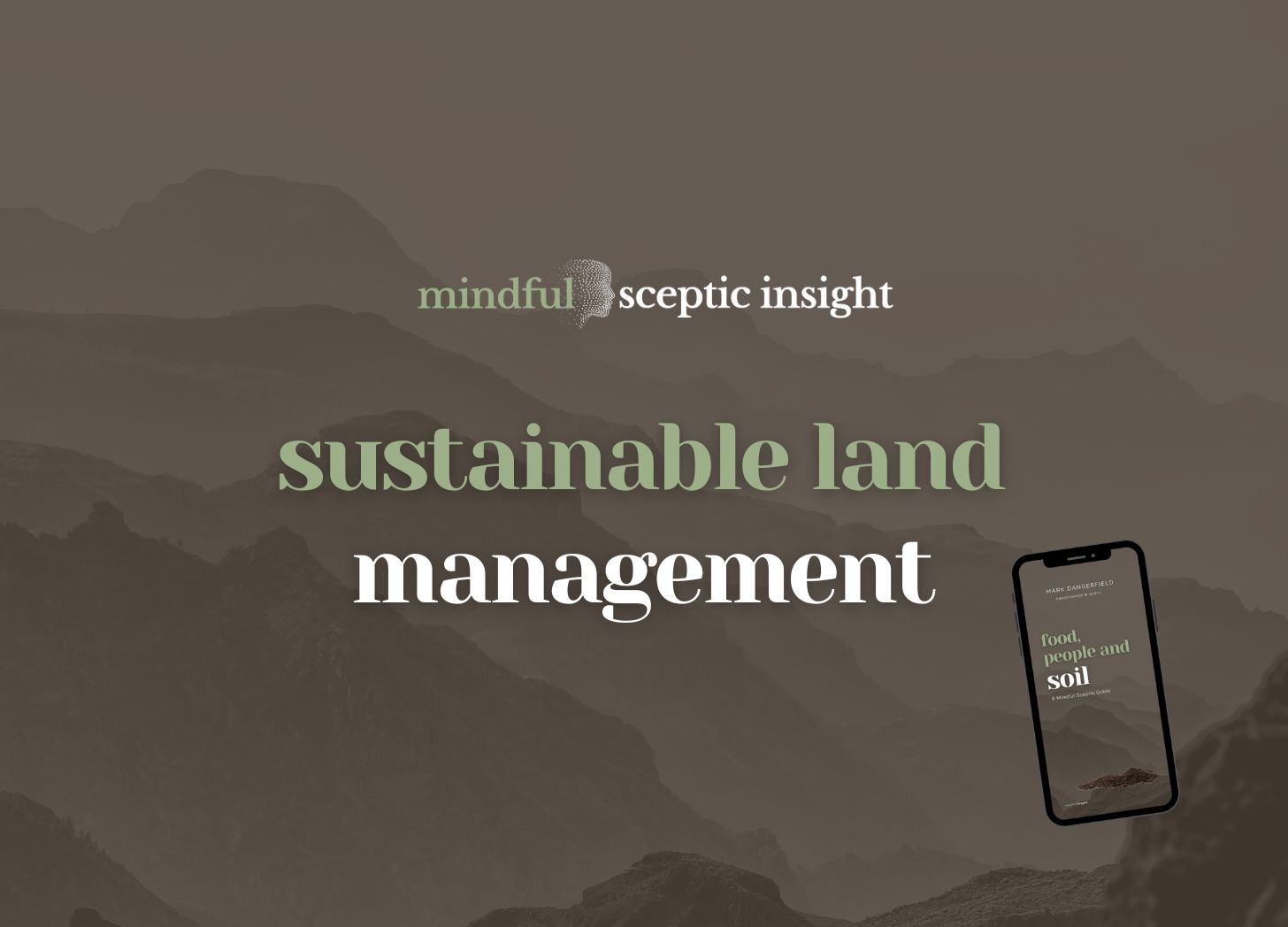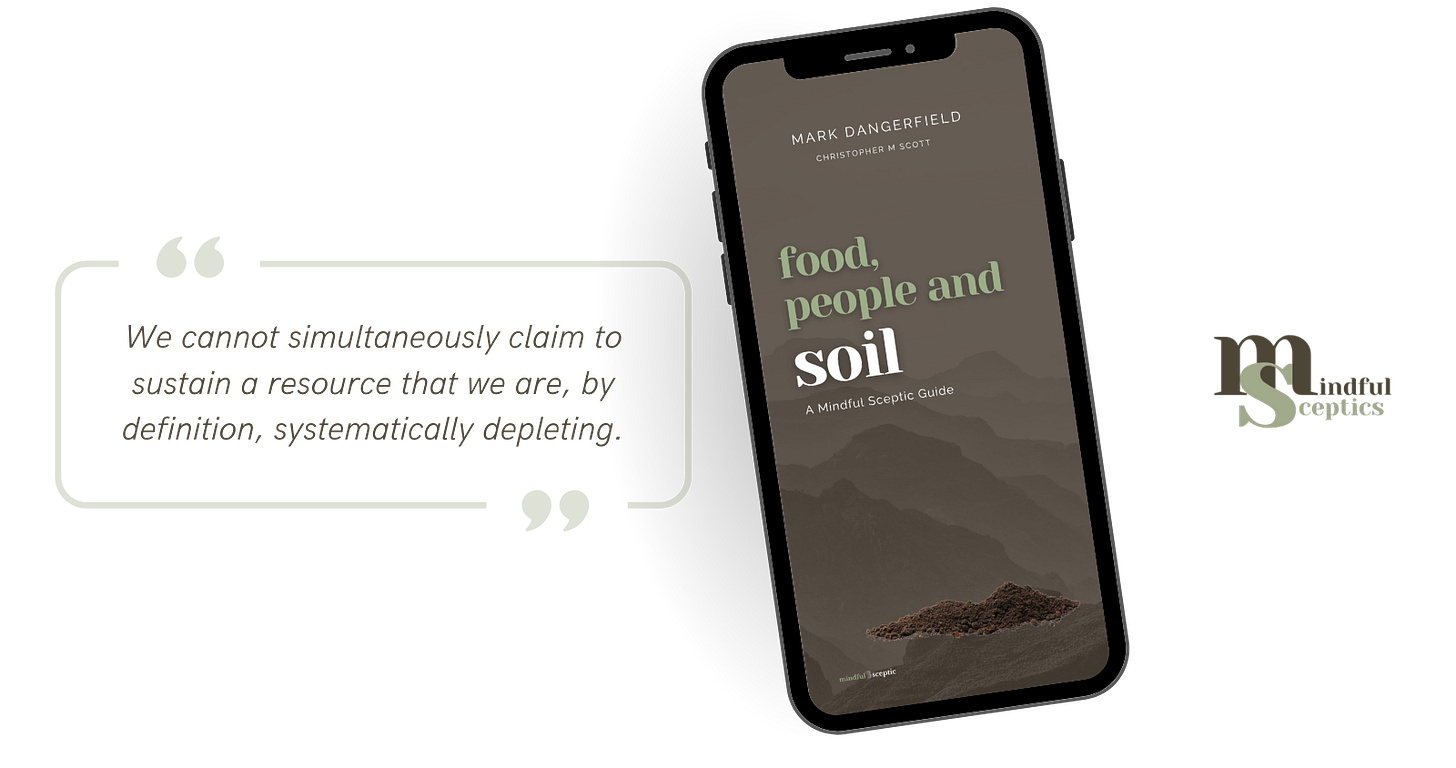Core Idea
The environmental movement promotes the idea that we can “protect, conserve, and restore” the land while taking nutrients from it with every harvest. This is akin to trying to fill a bucket with a gaping hole in the bottom.
Every crop that leaves a field is a net export of nutrients and carbon, creating a deficit in the soil it grew in. We cannot simultaneously claim to sustain a resource that we are, by definition, systematically depleting.
Given this inevitable extraction, the entire concept of “sustainable land management” is an oxymoron.
Counterpoint
Sustainable intensification and regenerative agriculture are presented as win-win solutions that allow us to farm productively while healing the land.
However, this comforting story overlooks the fundamental principles of matter and energy. At every harvest, biomass containing carbon, nitrogen, and phosphorus is removed from the farm. Those nutrients are transported to cities, consumed, and the resulting waste is flushed into waterways, rather than being returned to the fields of origin. The system is relentlessly linear.
The only reason modern agriculture appears sustainable is because of a massive, ongoing subsidy of fossil-fuel-derived fertilisers that masks the ever-growing soil debt.
The language of sustainability is a rhetorical sleight of hand to hide this fundamental extraction.
Thought Challenge
Perform a Supermarket Nutrient Audit… The next time you are in a supermarket, pick up a loaf of bread and ask yourself where the nitrogen and phosphorus in this wheat come from. The answer is likely not the soil, but a factory using the Haber-Bosch process, powered by natural gas. Then ask yourself, where will these nutrients go after I eat this bread? Not back to the farm, but to a wastewater treatment plant. This simple audit reveals the linear, extractive reality hidden behind the wholesome packaging.
Deconstruct the Language… Find a corporate or government report on “sustainable agriculture.” Make a list of all the verbs used to describe the actions on the land… sustain, restore, enhance, protect, improve. Now, list the physical actions of industrial farming… ploughing, harvesting, removing, exporting. The first list describes a marketing fantasy; the second describes the physical reality. The gap between them is the size of the oxymoron.
Closing Reflection
This insight is not a call for despair or the abandonment of farming. Nor is it a complaint against farmers who are doing the best they can with the systems they are given.
What I am asking is for some intellectual honesty. The problem is not that agriculture is extractive, but that we pretend it isn’t. A mindful sceptic understands that you cannot solve a problem you refuse to accurately name.
True stewardship of the land begins not with comforting stories of perpetual harmony, but with the clear-eyed acceptance that we are managing a deficit. The goal is to minimise the withdrawal and be honest about the cost of patching the bucket, not to pretend the hole doesn’t exist.
Evidence Support
Lal, R. (2004). Soil carbon sequestration impacts on global climate change and food security. Science, 304(5677), 1623-1627.
TL;DR… landmark paper quantifies how continuous cropping and biomass removal depletes soil organic carbon and nutrients, creating a persistent soil debt that undermines both long-term agricultural productivity and climate stability. The author shows that restoration and sequestration efforts are fundamentally undermined if extraction exceeds natural replacement rates.
Relevance to Insight… demonstrating that the arithmetic of nutrient removal and carbon loss in agriculture makes claims of “sustainability” fundamentally misleading unless the net export is honestly accounted for. This paper is foundational in exposing the oxymoron at the heart of industrial land management.
Galloway, J. N., Aber, J. D., Erisman, J. W., et al. (2003). The nitrogen cascade. BioScience, 53(4), 341-356.
TL;DR… how harvested nitrogen is transported from farms to cities, then lost to waterways rather than returned to soil, resulting in a relentless, linear depletion of agricultural lands. The authors detail consequences downstream of soil impoverishment, urban waste, and eutrophication.
Relevance to Insight… nutrient cycles are broken by industrial agriculture, confirming the insight’s claim that sustainable land management rhetoric masks fundamental extraction and loss.
Smil, V. (2001). Enriching the Earth: Fritz Haber, Carl Bosch, and the Transformation of World Food Production. MIT Press.
TL;DR… Smil documents how modern agriculture is not sustained by natural soil fertility but by artificial nitrogen produced via the Haber-Bosch process, a fossil energy-driven system that fails to restore original nutrient balances and instead deepens our reliance on external inputs.
Relevance to Insight… exposes the energetic subsidy that sustains agriculture, aligning precisely with the insight’s argument—that current productivity is a mask for systematic extraction and debt.
Pretty, J. N., Noble, A. D., Bossio, D., et al. (2006). Resource-conserving agriculture increases yields in developing countries. Environmental Science & Technology, 40(4), 1114-1119.
TL;DR… while showing yield increases from resource-conserving practices, this meta-analysis also highlights that sustainability claims often ignore cumulative nutrient deficits, and most systems remain heavily dependent on external (often fossil-fuel derived) fertilisers.
Relevance to Insight… recognition that “sustainable intensification” can be a rhetorical device rather than an achieved reality, especially when linear resource export is concealed.
Vitousek, P. M., Porder, S., Houlton, B. Z., & Chadwick, O. A. (2010). Terrestrial phosphorus limitation: mechanisms, implications, and nitrogen-phosphorus interactions. Ecological Applications, 20(1), 5-15.
TL;DR... phosphorus, unlike nitrogen, is exceptionally hard to recycle, so its removal via harvest and urban waste creates irreversible soil impoverishment, and that claims of regenerative or circular agriculture rarely match physical limits.
Relevance to Insight… solely technical or rhetorical solutions cannot close the systemic holes in soil nutrient cycles, underscoring the oxymoron inherent to “sustainable land management” under present systems.






